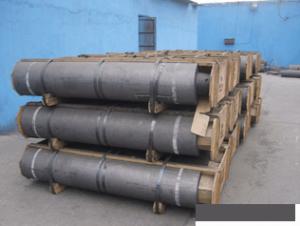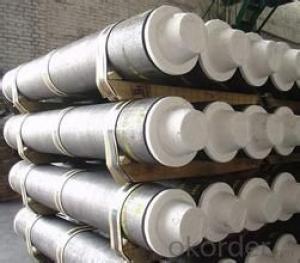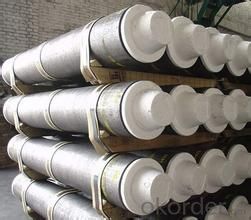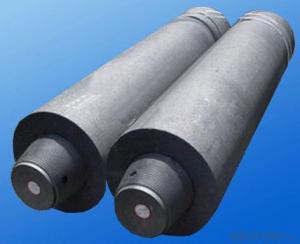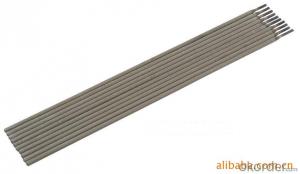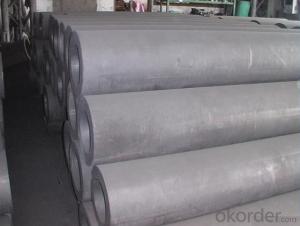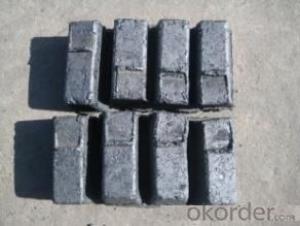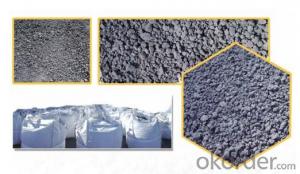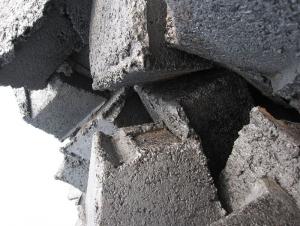Carbon Electrode with Different Size and High Quality
- Loading Port:
- Tianjin
- Payment Terms:
- TT OR LC
- Min Order Qty:
- 20 m.t.
- Supply Capability:
- 800 m.t./month
OKorder Service Pledge
OKorder Financial Service
You Might Also Like
Spcifications
1:carbon eletrode
2:for ferroalloy,calcium carbide, silicon metal, manufacture
Product Description
Carbon Electrode is abaked electrode used in submerged arc furnaces for delivering power to the charge mix. Electrode is added to the top of the electrode column cylindrical form. Electrode is essentially a mix of Electrically Calcined Anthracite (ECA) or Calcined Petroleum Coke (CPC) with Coal Tar Pitch and is baked for weeks, it is widly used for ferroally productiong, silicon metal production etc.
Graphite/Carbon Electrode Paste Specification:
| PARAMETER UNIT GUARANTEE VALUE | ||||||
| Items | Φ500~Φ700 | Φ750~Φ960 | Φ1020~Φ1400 | |||
| Rs μΩ.m | ≤45 | ≤38 | ≤45 | ≤38 | ≤40 | |
| Bulk Desity g/cm3 | ≥1.55 | ≥1.58 | ≥1.55 | ≥1.58 | ≥1.55 | ≥1.58 |
| Bending Strength MPa | 3.5~7.5 | 4.0~7.5 | 3.5~7.5 | 4.0~7.5 | 3.5~7.5 | 4.0~7.5 |
| Compressive Strength MPa | ≥20.0 | ≥20.0 | ≥20.0 | ≥20.0 | ≥19.0 | ≥19.0 |
| Compressive Strength MPa | 3.2~4.8 | 3.0~4.6 | 3.2~4.8 | 3.0~4.6 | 3.2~4.8 | 3.0~4.6 |
| Ash % | ≤2.5 | ≤2.0 | ≤2.5 | ≤2.0 | ≤2.5 | ≤2.0 |
Picture:
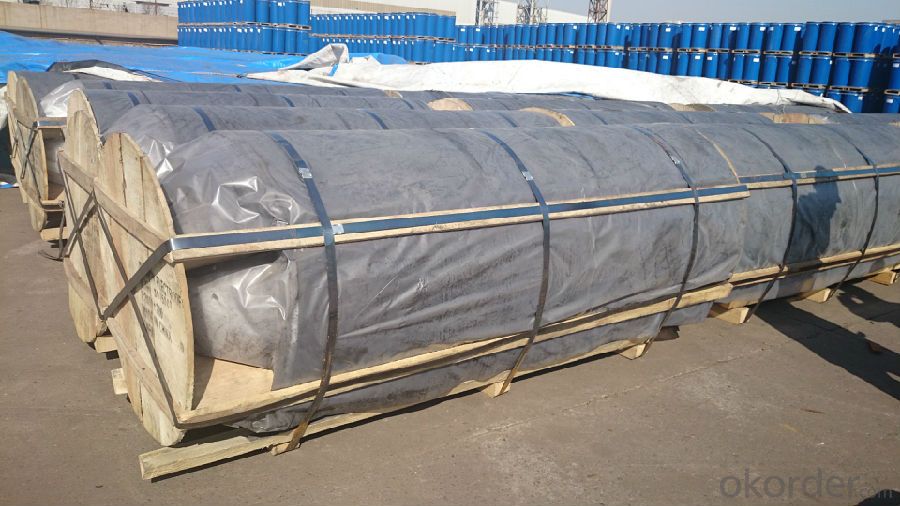
We Also supply all kind of carbon electrode paste and below materials, please contact us if you have any enquiry about it.
Calcined Anthracite
Calcined Petroleum Coke
Coke (Met Coke, Foundry Coke, Semi Coke)
Company information:
China National Building Materials Group is a stated -owned enterprise in charge of administrative affairs in China buiding materials industry.Established in 1984 CNBM is a large group corporation of building materials with total assets of 25 billion and a total stuff of 30000 CNBM now owns 200 subordinating firms of solely owned and joint-venture companies.
- Q: Appearance, hardness, electrical conductivity, use of carbon 60
- C60 is a molecule composed of 60 carbon atoms in the molecule, it is like football, so also known as footballene (C60. This material is composed of C60 molecules, rather than by the atoms.) C60 is simply made of carbon atoms with stable molecules, it has 60 vertices and 32 sides. The 12 is Pentagon and 20 hexagon. Its molecular weight is about 720.
- Q: How can I see if a battery can be used to recharge it?Can not all carbon batteries charge?
- Final conclusion:Carbon batteries, alkaline batteries are not charged, the voltage is 1.5V, nickel cadmium batteries, nickel hydrogen batteries can charge voltage 1.2VPay special attention to the risk of leakage or explosion if you charge to a carbon battery or alkaline battery
- Q: What are the impacts of carbon emissions on biodiversity?
- Biodiversity is significantly affected by carbon emissions, which have various consequences. One of the primary outcomes is climate change, which results from the release of greenhouse gases, including carbon dioxide, into the atmosphere. As the Earth's temperature increases, it disrupts the delicate balance of ecosystems, causing the loss of biodiversity. Habitat loss is a major effect of climate change on biodiversity. Many species are adapted to specific environmental conditions, and as these conditions change, their habitats become unsuitable. This can lead to the extinction of species that cannot adapt or migrate to new areas. For instance, coral reefs are highly sensitive to temperature changes, and with the ocean warming due to carbon emissions, numerous coral species are at risk of bleaching and dying off. Carbon emissions also disrupt ecological interactions, which are crucial for the survival of many species. Numerous species rely on specific relationships with other species, such as pollination or predation. Climate change can alter the timing of these interactions, potentially causing mismatches between species. For example, if flowering plants bloom earlier in the year due to warmer temperatures, but their pollinators are not yet active, it can result in reduced pollination and reproductive success. Furthermore, carbon emissions contribute to ocean acidification, which occurs when seawater absorbs carbon dioxide, leading to a decrease in pH. This acidification negatively affects marine organisms, especially those with calcium carbonate shells or skeletons, like corals, mollusks, and some plankton. The increased acidity makes it challenging for these organisms to build and maintain their protective structures, potentially causing population declines and disruptions in ecosystems. In general, the impacts of carbon emissions on biodiversity are extensive and profound. They not only threaten individual species but also disturb entire ecosystems and their functioning. To mitigate these effects, it is essential to reduce carbon emissions and transition to cleaner and more sustainable energy sources. Additionally, conserving and restoring habitats, implementing effective conservation strategies, and promoting sustainable land and water management practices can help protect and restore biodiversity in the face of climate change.
- Q: How does carbon impact the prevalence of ocean acidification?
- Carbon dioxide (CO2) is a greenhouse gas that contributes to climate change. When excess CO2 is released into the atmosphere through human activities such as burning fossil fuels, a significant portion of it gets absorbed by the oceans. This absorption of CO2 leads to a chemical reaction that increases the concentration of hydrogen ions in the water, resulting in a decrease in pH levels. This process is known as ocean acidification. Carbon dioxide dissolved in seawater creates carbonic acid, which then dissociates into hydrogen ions and bicarbonate ions. The increasing concentration of hydrogen ions decreases the availability of carbonate ions, which are crucial for shell-forming organisms such as corals, mollusks, and some planktonic species. These organisms rely on carbonate ions to build and maintain their shells or skeletons. As ocean acidification progresses, the saturation state of calcium carbonate, a key mineral in shell production, decreases. This makes it more difficult for marine organisms to build their shells, leading to reduced growth rates and weakened structures. Some organisms, such as corals and oysters, may even experience dissolution of their shells under extreme acidification conditions. The impact of ocean acidification extends beyond shell-building organisms. It affects the entire marine ecosystem as it disrupts the delicate balance of various species and their interactions. For example, the reduced availability of carbonate ions can impact the growth and survival of phytoplankton, which form the base of the marine food web. This, in turn, can affect the entire food chain, leading to cascading effects on fish populations and other marine organisms. Furthermore, ocean acidification can also impact the physiological functions of marine organisms, including their reproduction, behavior, and immune systems. Some studies suggest that acidification may impair the ability of certain fish species to detect predators or navigate, making them more vulnerable to predation and reducing their chances of survival. In conclusion, carbon emissions from human activities contribute to the prevalence of ocean acidification. The increased concentration of CO2 in the atmosphere leads to its absorption by the oceans, which subsequently lowers pH levels and reduces the availability of carbonate ions. This process has profound implications for shell-building organisms, the marine food web, and the overall health and biodiversity of our oceans. Addressing carbon emissions and mitigating climate change is essential to reduce the impacts of ocean acidification and preserve the health of marine ecosystems.
- Q: What are the effects of carbon dioxide on ocean acidity?
- Ocean acidity is significantly impacted by carbon dioxide (CO2), resulting in a phenomenon known as ocean acidification. When humans release CO2 into the atmosphere through activities like burning fossil fuels, the oceans absorb it. This absorption triggers chemical reactions that form carbonic acid, which lowers the pH of seawater. The increased concentration of carbonic acid in the oceans disrupts the delicate balance of carbonate ions, which are necessary for the formation of calcium carbonate. Numerous marine organisms, including coral reefs, shellfish, and plankton, rely on calcium carbonate to construct their shells and skeletons. As the ocean becomes more acidic, the concentration of carbonate ions decreases, making it increasingly challenging for these organisms to create and maintain their protective structures. Ocean acidification poses a significant threat to marine ecosystems and biodiversity. Coral reefs, for example, are particularly vulnerable to acidification. As acidity increases, corals struggle to build and maintain their calcium carbonate structures, resulting in bleaching and eventual death of the reefs. The loss of coral reefs has severe consequences for the countless species that depend on them for food, shelter, and reproduction. Additionally, other marine organisms such as shellfish and plankton are also affected by ocean acidification. Shellfish, including oysters, clams, and mussels, rely on calcium carbonate for their shells. As acidity rises, the availability of carbonate ions decreases, making it harder for these organisms to construct their protective shells. This can lead to reduced populations of shellfish, impacting not only the organisms themselves but also the industries and communities that rely on them economically and culturally. Plankton, the foundation of the marine food web, are also susceptible to the effects of increased ocean acidity. Many plankton species possess calcium carbonate structures that provide buoyancy and protection. As acidity rises, these structures weaken, making it more difficult for plankton to survive and reproduce. This disruption in the plankton community can have far-reaching consequences for the entire marine food chain, impacting fish, marine mammals, and ultimately, humans who rely on seafood as a primary source of protein. In conclusion, the impact of carbon dioxide on ocean acidity is significant and concerning. Ocean acidification jeopardizes the health and stability of marine ecosystems, affecting crucial organisms like coral reefs, shellfish, and plankton. Understanding and addressing this issue are crucial for the long-term health of our oceans and the countless species that depend on them.
- Q: How does carbon affect the melting of polar ice caps?
- Carbon affects the melting of polar ice caps by contributing to global warming. As carbon dioxide levels increase in the atmosphere, it acts as a greenhouse gas, trapping heat and causing the Earth's temperature to rise. This leads to the melting of polar ice caps, as the increased temperatures accelerate the melting process, causing the ice to melt at a faster rate.
- Q: Wrought iron, steel, cast iron, cast iron, according to the content of the carbon? How many?
- That is not all according to the carbon content is divided. Because the carbon content of iron and iron.
- Q: How does carbon dioxide affect the pH of soil?
- Soil pH can be influenced by carbon dioxide through a process known as carbonation. When carbon dioxide dissolves in water, it creates a weak acid called carbonic acid (H2CO3). This acid can react with certain minerals and compounds, such as limestone or calcium carbonate, found in the soil, causing them to dissolve. As a result, positively charged ions like calcium (Ca2+) or magnesium (Mg2+) are released into the soil solution, which can raise the pH or make the soil more alkaline. Moreover, the presence of carbonic acid can also increase the availability of specific nutrients in the soil. For instance, it can enhance the solubility of phosphorus, making it easier for plants to absorb. This can ultimately improve soil fertility. However, it's important to consider that the impact of carbon dioxide on soil pH can vary due to different factors, including the concentration of carbon dioxide, soil type, and the presence of buffering agents. In some cases, the soil's buffering capacity can limit the effects of carbonic acid on pH changes. Therefore, while carbon dioxide can influence soil pH, it is just one of many factors that can affect the overall acidity or alkalinity of the soil.
- Q: How does carbon affect the acidity of oceans?
- Carbon dioxide (CO2) is a major contributor to the acidity of oceans. When CO2 is released into the atmosphere through human activities such as burning fossil fuels and deforestation, a significant portion of it is absorbed by the oceans. This process, known as ocean acidification, leads to an increase in the concentration of hydrogen ions in the water, resulting in a decrease in pH levels and an increase in acidity. When CO2 dissolves in seawater, it reacts with water molecules to form carbonic acid (H2CO3). This reaction releases hydrogen ions (H+), which increase the acidity of the water. The increased acidity affects the delicate balance of chemical reactions that support life in the ocean, particularly those involving calcium carbonate. Calcium carbonate is a vital component in the formation of shells and skeletons of many marine organisms, including corals, shellfish, and some plankton. As the acidity of the ocean increases, it becomes harder for these organisms to build and maintain their calcium carbonate structures. This can lead to reduced growth rates, weakened shells, and increased vulnerability to predators and disease. Ocean acidification also affects the entire marine food web. Many species rely on shell-forming organisms as a food source or as habitat, and their decline can have cascading effects on the entire ecosystem. Additionally, acidification can disrupt the balance of phytoplankton, the microscopic plants that are the foundation of marine food chains. Furthermore, carbon dioxide in the ocean can react with water to form bicarbonate ions (HCO3-) and carbonate ions (CO32-). These ions are essential for maintaining proper pH levels and the ability of marine organisms to regulate their internal chemistry. However, as CO2 levels rise, the concentration of carbonate ions decreases, making it more difficult for organisms to access the carbonate they need to build their shells and skeletons. Overall, the impact of carbon on ocean acidity is significant and has far-reaching consequences for marine life. It is crucial to reduce carbon emissions and take measures to mitigate and adapt to the effects of ocean acidification in order to protect the health and biodiversity of our oceans.
- Q: What are the main factors that affect the strength of carbon fibers?
- [Abstract]: the interface play on the properties of carbon fiber composite material plays a very important role, the composite load transfer through the interface, can make the carbon fiber and the matrix to form an effective performance of the whole. In the study of the interface, improving the bonding strength is the key to improve the mechanical properties of the carbon fiber composite. Therefore, it is very important to analyze the influence of various factors on the interfacial bonding strength of carbon fiber reinforced composites for improving the comprehensive properties of composites. In this paper, by using scanning electron microscopy (SEM), X ray photoelectron spectroscopy (XPS), laser Raman spectroscopy (LRS), X ray diffraction (XRD) and Fu Liye transform infrared spectroscopy (FTIR) and mechanical testing technology, investigated the effect of different preparation processes on the structure and properties of carbon fiber, discusses the evolution of the structure and properties of the carbon fiber surface process and electrochemical treatment in the process of electrochemical modification prepared by wet spinning PAN based carbon fiber, the carbon fiber surface except the rationality of glue craft, in-depth study of the carbon fiber electrochemical treatment, sizing agent and matrix modification effect on the bonding strength of carbon fiber composite the carbon fiber material, electrochemical modification mechanism and matrix modification mechanism.
Send your message to us
Carbon Electrode with Different Size and High Quality
- Loading Port:
- Tianjin
- Payment Terms:
- TT OR LC
- Min Order Qty:
- 20 m.t.
- Supply Capability:
- 800 m.t./month
OKorder Service Pledge
OKorder Financial Service
Similar products
Hot products
Hot Searches
